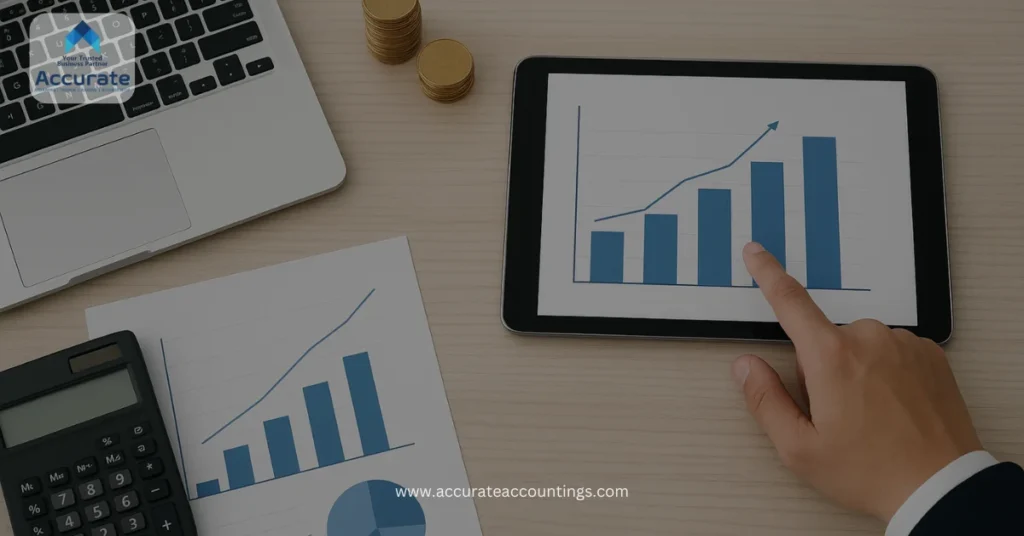Financial KPIs Every Business Owner Should Track

Dammam is one of Saudi Arabia’s fastest-growing business hubs, offering excellent opportunities for trade, services, and manufacturing. If you’re planning company formation in Dammam, tracking financial KPIs from day one is crucial—it ensures cost control, attracts investors, and builds long-term stability. This blog will explore some critical finance KPIs that aspiring entrepreneurs should know. Let’s dive deep into it.
Financial KPIs for Startup Businesses in Dammam
Company formation in Dammam is the first step. To ensure complete success and long-term growth, business owners must track key financial KPIs. Here are some essential KPIs that can help you climb the ladder in the business world.
Current Ratio
The ratio between what a company owns, like cash and inventory, and what a company owes, like bills and loans, is called the current ratio.
Current ratio = Current Assets ÷ Current Liabilities
Ratio above 1 implies Healthy liquidity.
Ratio below 1 implies Potential cash flow issues.
Break-Even Point
When it comes to a company’s growth, there comes a point where income = costs.
At this point, profit = zero.
This Break-Even Point helps businesses know the minimum sales needed to cover expenses.
After crossing this point, any extra sales lead to profit for the company.
Revenue Growth Rate
When it comes to business productivity, knowing the percentage increase in your company’s sales is important. That is exactly what the Revenue Growth Rate indicates. By checking that, you can learn how quickly your business is expanding its income.
A higher Revenue Growth Rate implies successful marketing, sales strategies, or product demand.
A lower Revenue Growth implies competitive challenges that need strategic adjustments.
Accounts Receivable Turnover
How quickly a company collects money from customers after making a sale is indicated by Accounts Receivable Turnover.
The greater the Accounts Receivable Turnover, the faster the payments are made by customers.
A decent Accounts Receivable Turnover indicates that the company is maintaining a healthy cash flow.
A low turnover points to payment delays or issues with credit policies that affect business finance.
Operating Cash Flow (OCF)
From its regular operations, the amount of cash a business generates represents Operating Cash Flow. It focuses solely on core business functions, excluding financing and investing activities.
Positive OCF means businesses have enough cash from their operations and healthy liquidity to pay debts, reinvest, and sustain growth without relying on external funding.
Gross Profit Margin
Gross profit margin shows the percentage of revenue remaining after subtracting the cost of goods sold (COGS). What is reflected there is the pricing strategy and production efficiency of the company.
A higher Gross Profit Margin indicates the business retains more money that can be used to cover the expenses and generate profits.
Debt-to-Equity Ratio
The ratio between how much money a company borrows (debt) and how much money owners invest (equity) is called the debt-to-equity ratio.
Debt-to-Equity Ratio = (All short-term and long-term liabilities)/(Owners’ investments + retained earnings)
The higher ratio indicates financial risk, which means the company is increasingly dependent on loans.
The low ratio indicates the company is using more of its own funds, which reduces financial risk.
Net Profit Margin
Net Profit = Revenue – Expenses (including taxes, interest, and operating costs)
Revenue = Total income from sales or services.
Net Profit Margin = (Net Profit)/(Revenue) * 100
The net profit margin indicates the overall profitability and financial health. A higher margin implies more profitability. It indicates strong cost control, efficient operations, and effective pricing strategies. Thus, all in all, net profit margin is vital for evaluating long-term sustainability.
Return on Investment (ROI)
Net profit = Total Revenue – Total Costs
Cost of Investment = Total amount invested in the projects, marketing, or equipment
Return on Investment (%)= (Net Profit) / (Cost of Investment)*100
How much profit an investment makes when compared to its cost is indicated by Return on Investment (ROI).
Shown as a percentage, a higher ROI means the investment brought good returns.
Companies use ROI to decide if spending on projects, marketing, or equipment is worth the money.
Categorising KPIs by Business Stage
Startup Stage: Break-Even Point, OCF, Current Ratio.
Growth Stage: Revenue Growth Rate, Accounts Receivable Turnover, Gross Profit Margin.
Maturity Stage: ROI, Net Profit Margin, Debt-to-Equity Ratio.
Essential Services for Company Formation and Financial KPI Tracking
When it comes to businesses, they need services including company registration, licensing, permits, VAT & Zakat registration, accounting, auditing, and so on. The comprehensive services guarantee a reduction in coordination hassles, saving you time and effort. For smooth handling of your business, you need the support of an expert team that is proficient in Saudi Arabia’s laws, regulations, compliance standards, and licensing procedures.
Accurate Solutions’ accounting and financial reporting services help businesses easily track KPIs from day one. Our goal is to ensure a smooth and hassle-free company formation process, providing support at every stage of your business growth journey. We guarantee to avoid delays, legal issues, or unexpected costs, providing a trouble-free business setup in Dammam that aligns with your vision.
Conclusion
Tracking the right KPIs at each stage of your business ensures financial stability and long-term growth. At Accurate Solutions, we provide hassle-free company formation in Dammam along with expert accounting support to keep your business on track.
Ready to start your journey? Partner with us today.
Ready to start your business in KSA? Contact us today for free expert guidance!
Ready to start your business in KSA?



